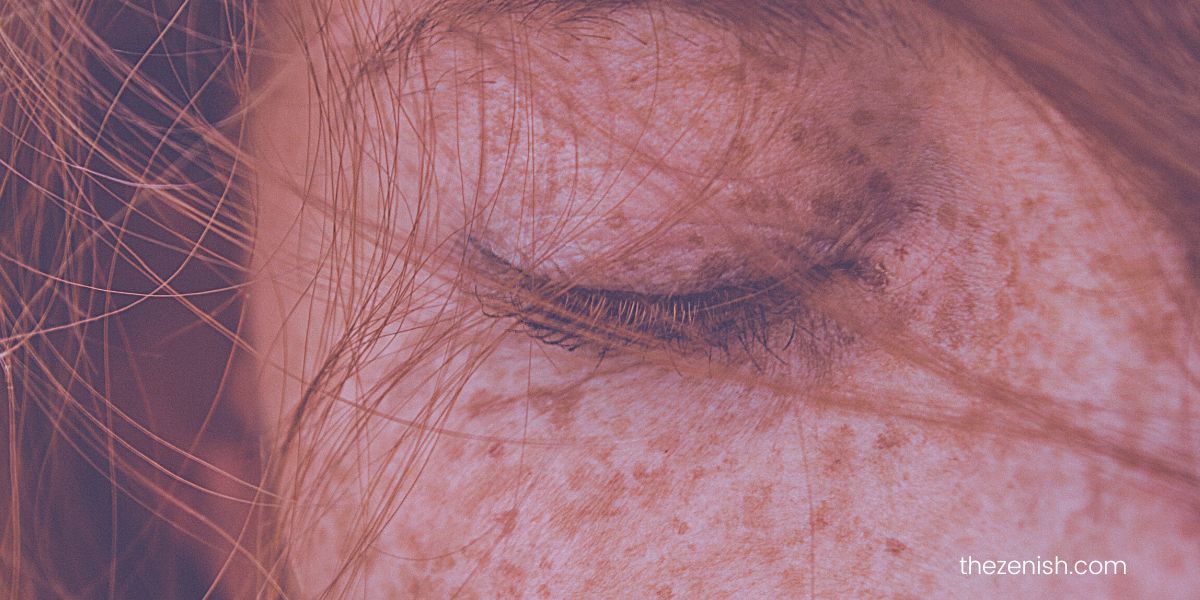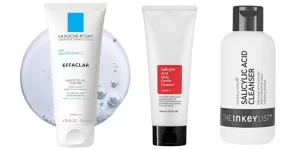
Dealing with skin discoloration and wondering if it’s hyperpigmentation or just freckles?
While both conditions can result in dark spots on your skin, there are some key differences between the two.
So, if you’re struggling with skin discoloration and wondering about the differences between hyperpigmentation vs freckles, keep reading.

What is hyperpigmentation?
Hyperpigmentation is a broader term that refers to any darkening of the skin, which can be caused by a variety of factors like hormonal changes, inflammation, and sun damage.
If you notice dark spots or patches on your skin, you may be experiencing hyperpigmentation.
Hyperpigmentation is common and occurs when the skin produces too much melanin (a pigment that gives color to your skin, hair, and eyes).
This excess melanin can result in dark spots or patches on your skin that can cause self-consciousness.
Types of hyperpigmentation
There are several types of hyperpigmentation that can occur on the skin. The most common types are:
- Age spots: Also known as liver spots or solar lentigines, age spots are flat, brown or black spots that appear on areas of the skin that have been exposed to the sun, such as your face, hands, and arms.
- Sun spots: Sun spots are similar to age spots and are caused by sun exposure. They are typically smaller and appear in clusters.
- Post-inflammatory hyperpigmentation: This type of hyperpigmentation occurs after the skin has been inflamed or injured, like from acne, eczema, or a cut or scrape. The skin may darken as it heals, leaving behind a dark spot or patch.
- Melasma: Melasma is a type of hyperpigmentation that is more common in women and is often associated with hormonal changes, such as during pregnancy or with the use of birth control pills. It can appear as brown or gray-brown patches on the face, particularly on the cheeks, forehead, nose, and chin.
See also: Melasma vs Hyperpigmentation: understanding the difference
- Seborrheic keratoses: Seborrheic keratoses are non-cancerous growths that can appear on the skin as brown or black spots. They are more common in older adults and can be mistaken for age spots.
Hyperpigmentation can happen in people of all skin types, but it’s more noticeable in people with darker skin tones.
If you are experiencing hyperpigmentation, there are several treatment options available, such as topical creams, chemical peels, and laser therapy.
You should also consult with a dermatologist to determine the best course of treatment for your skin.
What are freckles?
Freckles are small, flat spots that are usually found on sun-exposed areas of your body, such as your face, arms, and shoulders.
They are tan, red, light brown, or dark brown in color and are caused by an overproduction of melanin, the pigment that gives color to your skin, hair, and eyes.
Freckles are really common and aren’t usually a cause for concern.
Freckles are more often seen in the summer when your skin is exposed to more sunlight.
People with lighter skin and eyes, as well as those with red hair and fair skin, are more likely to get freckles, as they have a gene that makes them more susceptible to sun damage.
Freckles are harmless and don’t require treatment.
However, if you want to reduce their appearance, you can try using sunscreen with a high SPF, wearing protective clothing, or using skin-lightening products.
Just use caution with skin-lightening products, as they can have side effects and should only be used under the guidance of a dermatologist.
Hyperpigmentation vs freckles
Both hyperpigmentation and freckles can cause brown spots, but they have different causes and treatments.
Let’s explore the differences and similarities between these two conditions.
Here’s a concise chart comparing hyperpigmentation and freckles:
| Hyperpigmentation | Freckles | |
|---|---|---|
| Definition | Patches of darkened skin due to overproduction of melanin | Small, flat, brown spots on sun-exposed skin |
| Causes | Overproduction of melanin | Increase in melanocyte cells |
| Types | Post-inflammatory hyperpigmentation, melasma, solar lentigines | N/A |
| Severity | More severe | Usually harmless |
| Medical condition | Can be a symptom of underlying condition | Generally doesn’t require medical attention |
| Triggers | Sun exposure, hormonal changes, certain medications | Sun exposure, hormonal changes, certain medications |
| Treatment options | Topical creams, laser therapy | Topical creams, laser therapy |
Differences
Hyperpigmentation can make patches of skin appear darker than the skin surrounding it. This is usually caused by an overabundance of melanin, which is what gives your skin its color.
There are several types of hyperpigmentation, such as post-inflammatory hyperpigmentation, melasma, and solar lentigines.
On the other hand, freckles are small, flat, brown spots that appear on sun-exposed skin.
They are caused by an increase in the number of melanocytes, the cells that produce melanin.
Generally, they are harmless and don’t require treatment, but they can be a cosmetic concern for some people.
Similarities
Both hyperpigmentation and freckles are caused by an increase in melanin production, which can be triggered by sun exposure, hormonal changes, and certain medications.
Both can be treated with topical creams and laser therapy.
However, hyperpigmentation is usually more severe than freckles and can be a symptom of an underlying medical condition, whereas freckles are usually harmless and do not require medical attention.
What causes hyperpigmentation?
There are several factors that can cause hyperpigmentation, including UV exposure, hormonal changes, skin trauma, medications, and medical conditions.
UV Exposure
Excessive sun exposure can cause hyperpigmentation, especially in areas that are frequently exposed to the sun, such as your face, neck, and hands.
UV rays can stimulate the production of melanin, causing dark spots to appear on your skin.
Hormonal Changes
Hormonal changes in your body can also cause hyperpigmentation.
Pregnant women especially may develop a condition called melasma, which causes dark patches on their face.
Hormonal changes during menopause can also cause hyperpigmentation.
Skin Trauma
Skin trauma, such as acne scars, can also cause hyperpigmentation.
When your skin is injured, it produces more melanin in an attempt to repair the damage.
This can lead to dark spots or patches on your skin.
Medications
Some medications can cause hyperpigmentation as a side effect.
For example, some antibiotics, antipsychotics, and chemotherapy drugs can cause dark spots to appear on your skin.
Medical Conditions
Medical conditions such as post-inflammatory hyperpigmentation and acanthosis nigricans can also cause hyperpigmentation.
Post-inflammatory hyperpigmentation occurs when your skin produces too much melanin in response to an injury or inflammation.
Acanthosis nigricans causes dark patches on your skin, usually in areas where your skin folds, such as your neck, armpits, and groin.
What causes freckles?
Freckles are caused by an increase in the production of melanin, the pigment that gives color to your skin, hair, and eyes. They can also be due to:
Genetics
One of the main causes of freckles is genetics.
If your parents or other family members have freckles, you are more likely to develop them too.
There is a freckle gene that is passed down from generation to generation, and some people are simply more prone to developing freckles than others.
Sun Exposure
Another major cause of freckles is exposure to ultraviolet (UV) radiation from the sun.
When your skin is exposed to the sun, it produces more melanin to protect itself from harmful UV rays.
This increased production of melanin can lead to the development of freckles, especially if you have fair skin.
Other causes
UV exposure isn’t the only cause of freckles, but it is the most common one.
Other factors that can contribute to the development of freckles include hormonal changes, certain medications, and medical conditions like xeroderma pigmentosum.
To help prevent freckles, protect your skin from the sun by wearing sunscreen, hats, and protective clothing.
If you already have freckles, there are various treatments available, like laser therapy and chemical peels, but these are typically used for cosmetic purposes only and aren’t necessary for everyone.
See also: 23 Best facial cleansers for dark spots and hyperpigmentation
Risk factors for hyperpigmentation and freckles
If you’re concerned about hyperpigmentation or freckles, it’s important to understand the associated risk factors. Here are some factors that may increase your risk:
Darker skin types
Individuals with darker skin types are more prone to hyperpigmentation due to having more melanin.
When skin is exposed to UV radiation, it triggers the production of more melanin, resulting in hyperpigmentation.
Middle age
As you age, your skin becomes more susceptible to hyperpigmentation due to a decrease in your skin’s natural ability to repair itself and the cumulative effects of UV radiation exposure.
Pregnancy
Pregnant women are at an increased risk of developing hyperpigmentation due to hormonal changes during pregnancy, which can trigger the production of more melanin and lead to a condition called melasma, causing dark patches to appear on the face.
UV radiation
Exposure to UV radiation is one of the primary causes of hyperpigmentation and freckles.
UV radiation from the sun can damage the skin and trigger the production of more melanin.
Which can lead to hyperpigmentation, freckles, and other skin discolorations.
MC1R gene
The MC1R gene is responsible for the protein that controls the production of melanin in the skin.
Individuals with certain variations of this gene may be more prone to developing freckles, as these variations can lead to an overproduction of melanin in response to UV radiation.
Prevention and treatment for hyperpigmentation and freckles
To prevent or treat hyperpigmentation and freckles, you should take steps to protect your skin from the sun and use the appropriate skincare products.
See also: Adapalene vs Tretinoin: Which one is better for hyperpigmentation?
Here are some tips for preventing and treating hyperpigmentation and freckles:
Sun protection
The most important step you can take to prevent hyperpigmentation and freckles is to protect your skin from the sun.
This means using broad-spectrum sunscreen with an SPF of at least 30 every day, even on cloudy days.
You could also wear protective clothing, such as a hat or shirt with sleeves, and avoid spending too much time in the sun during peak hours.
Topical treatments
If you already have hyperpigmentation or freckles, there are several topical treatments you can use to help reduce their appearance.
Vitamin C (a popular ingredient found in many skincare products) can help brighten your skin and reduce hyperpigmentation.
Glycolic acid is another ingredient that can help exfoliate your skin and reduce the appearance of freckles.
See also: Does salicylic acid help hyperpigmentation and dark spots?
Professional treatments
If you have severe hyperpigmentation or freckles, you may need to see a skin specialist for medical treatment.
Laser treatments and liquid nitrogen can be used to remove freckles and other types of hyperpigmentation.
Laser hair removal can also help reduce the appearance of freckles by destroying the hair follicles that produce them.
Remember, prevention is key when it comes to hyperpigmentation and freckles. Protect your skin from the sun, use the right skincare products, and see a skin specialist if you need medical treatment.
When to see a doctor
If you have freckles or hyperpigmentation, it’s usually not necessary to see a doctor. However, there are certain situations when you should seek medical attention.
New spot or irregular border
If you notice a new spot on your skin or an existing spot that changes in size, shape, or color, see a doctor.
This could be a sign of skin cancer, including malignant melanoma.
Look for spots that have an irregular border and patches of skin that are different colors.
Family history of skin cancer
If you have a family history of skin cancer, you should be extra vigilant about monitoring your skin.
And talk to your doctor about how often you should have a skin exam.
Changes in existing spots
If you have existing freckles or spots that start to change, it’s important to have them checked by a doctor. This could be a sign of something more serious.
Sun damage
If you have a lot of sun damage, you should have regular skin exams.
This is especially important if you have fair skin or a history of sunburns.
Prevention
To prevent freckles and hyperpigmentation, protect your skin from the sun.
Wear sunscreen with an SPF of at least 30, and wear protective clothing, such as a hat and long-sleeved shirt, when you are outside.
Additionally, avoid using tanning beds, as they can also damage your skin.
Final thoughts
Hyperpigmentation and freckles can affect anyone, regardless of age or skin type.
If you’re looking for an effective treatment to reduce their appearance, it’s best to consult a dermatologist.
They can recommend the best ways to achieve the best results for your skin type and condition.
One of the primary causes of hyperpigmentation and freckles is UV damage.
Therefore, it is important to protect your skin from the sun’s harmful rays by wearing sunscreen with a high SPF rating every day.
This will help prevent further damage to your skin and reduce the risk of developing new freckles or hyperpigmentation.



